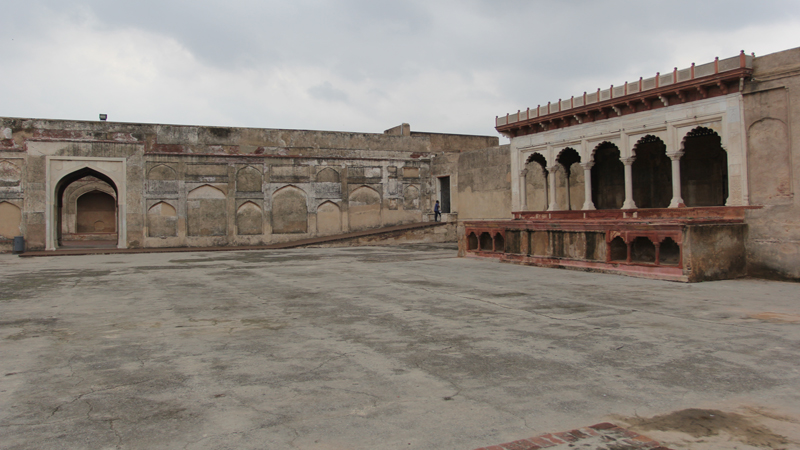 I think some parts of the regal and magnificent Lahore Fort are buried under the dust of times and no one has stepped forward to make those portions alive and listen to their unheard tales.
I think some parts of the regal and magnificent Lahore Fort are buried under the dust of times and no one has stepped forward to make those portions alive and listen to their unheard tales.
Among many such places in fort is also the Darbar or Court of Maharaja Ranjeet Singh which is Ath Dara, and I am sure that many of you while reading this would be amazed at this name ‘Ath Dara’ which mean ‘Eight Openings’. The building was named so because it has eight openings!
Let me take you to this astounding masterpiece of Sikh era that was added in the Mughals’ Lahore Fort. Maharaja Ranjeet Singh knew that the heart of the fort was the Sheesh Mahal so he chose to be near that place.
As you enter the fort and make your way to the Elephant Stairs which lead you to the original entrance of Sheesh Mahal through Shah Burj Gate, you will see this elevated pavilion outside the building of Sheesh Mahal. Ath Dara and the Sheesh Mahal quadrangle have a common wall in between. Maharaja built the court outside Sheesh Mahal and his private Chamber inside Sheesh Mahal by adding another floor on it.
As you enter the fort and make your way to the Elephant Stairs which lead you to the original entrance of Sheesh Mahal through Shah Burj Gate, you will see this elevated pavilion outside the building. Ath Dara and the Sheesh Mahal quadrangle have a common wall in between
According to historic notes Maharaja Ranjeet Singh occupied Lahore in 1799 and rule for good 40 years and became Sher-e-Punjab. I think he wanted to have an empire and a military like the Mughals and that is why he adored opulence and majesty. This is why Maharaja Ranjeet Singh chose to build his private chamber in Sheesh Mahal which was built by Mughal Emperor Shah Jahan for his queen who could not enjoy its beauty and died before its completion. Anyhow, the same place Maharaja chose for his court and thus he ordered the construction of Ath Dara which was a simple but richly decorated for several occasions and gatherings.
According to historic accounts it can be gathered that Maharaja spent his early years in affluence and radiance may be he wanted to copy the Mughals in their opulence and lifestyle. So it is there in several accounts that his chamber was skilfully decorated and candles or oil lamps were a part of post sunset décor.
While reading about the décor of the Shah Burj quadrangle which also includes the Sheesh Mahal was decorated with silk curtains flowing with the breeze which is still felt there, gold and silver embroidery on the curtains and carpets made them shine like stars on walls and ground. Imagine the glory and charisma of the place in those times, but who knew that the British would put an end to that lavish style of the Mughals and Sikhs. It is said that even the tents had gold and silver ornamentation and décor just like there used to be during the Mughal rule in Deewan-e-Aam gardens or other spaces in fort.
So this Sikh era elevated pavilion which you see now was once the mark of richness and grandeur of the Sikh empire.
You will be surprised to know that Ath Dara was built, and used as Kacheri which means a Court, by Maharaja Ranjeet Singh. It is said that his courtiers suggested him to take over the marble throne of Deewan-e-Khas o Aam but he refused all options and selected this place for his court.
It is also said that instead of a traditional throne he chose to sit on a chair specially designed for him. One of his chairs is in Lahore Museum while the gold one is now in the Victoria and Albert Museum. Now if by chance you are at Ath Dara do visualise the court of Maharaja with his gold chair.
 With the passage of time the building of Ath Dara got neglected and the access to the pavilion was not available as the stairs went missing.
With the passage of time the building of Ath Dara got neglected and the access to the pavilion was not available as the stairs went missing.
If you go inside this building of Ath Dara you will still see a beautiful ceiling with richly carved woodwork and mirrors. Similar ceilings are seen in some of the other places of Lahore Fort which were added by the Sikhs and also in a couple of Sikh Havelis located in old Lahore. I can imagine how the ceiling would sparkle at night with the lights touching it from the oil lamps and candles lit up.
Frescos paintings cover with gold are also seen in Ath Dara and it is said that the artisans of the Sikh Court were deputed on fresco work there. Red sand stone and marble has been generously used in decorating the pavilion and all these were carried forward from the Mughal architecture. If you closely look at this structure and compare it with the Huzoori Bagh pavilion you will see a lot of resemblance.
At present the pavilion of Ath Dara has been illuminated by the Walled City of Lahore Authority and tourists can see this wonder during the night when this place has a groovy romantic mood. If you are visiting this place at night, only then you will be able to understand why Maharaja chose this place for his private chamber and court. It’s a must visit site!
The writer can be reached at taniashahab2016@gmail.com